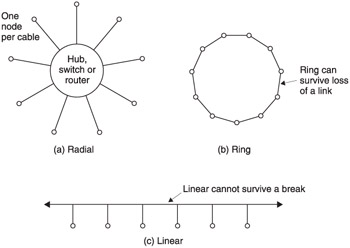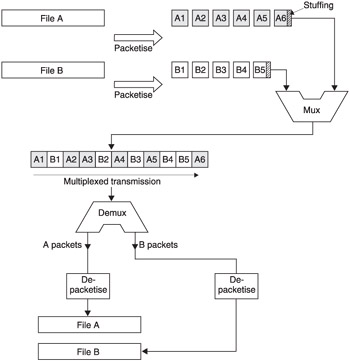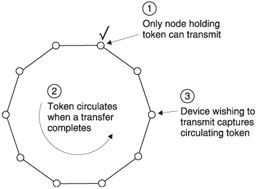3.21 Networks
| | ||
| | ||
| | ||
3.21 Networks
A network is basically a communication resource shared for economic reasons. Like any shared resource, decisions have to be made, somewhere and somehow, how the resource is to be used. In the absence of such decisions the resultant chaos will be such that the resource might as well not exist. In communications networks the resource is the ability to convey data from any node or port to any other. On a particular cable, clearly only one transaction of this kind can take place at any one instant even though in practice many nodes will simultaneously be wanting to transmit data. Arbitration is needed to determine which node is allowed to transmit.
There are a number of different arbitration protocols and these have evolved to support the needs of different types of network. In small networks, such as LANs, a single point failure halting the entire network may be acceptable, whereas in a public transport network owned by a telecommunications company, the network will be redundant so that if a particular link fails data may be sent via an alternative route. A link that has reached its maximum capacity may also be supplanted by transmission over alternative routes.
In physically small networks, arbitration may be carried out in a single location. This is fast and efficient, but if the arbitrator fails it leaves the system completely crippled. The processor buses in computers work in this way. In centrally arbitrated systems the arbitrator needs to know the structure of the system and the status of all the nodes. Following a configuration change, due perhaps to the installation of new equipment, the arbitrator needs to be told what the new configuration is, or have a mechanism which allows it to explore the network and learn the configuration. Central arbitration is only suitable for small networks that change their configuration infrequently.
In other networks the arbitration is distributed so that some decisionmaking ability exists in every node. This is less efficient but it does allow at least some of the network to continue operating after a component failure. Distributed arbitration also means that each node is self-sufficient and so no changes need to be made if the network is reconfigured by adding or deleting a node. This is the only possible approach in wide area networks where the structure may be very complex and change dynamically in the event of failures or overload.
Ethernet uses distributed arbitration. FireWire is capable of using both types of arbitration. A small amount of decision-making ability is built into every node so that distributed arbitration is possible. However, if one of the nodes happens to be a computer, it can run a centralized arbitration algorithm.
The physical structure of a network is subject to some variation as Figure 3.38 shows. In radial networks (a) each port has a unique cable connection to a device called a hub . The hub must have one connection for every port and this limits the number of ports. However, a cable failure will only result in the loss of one port. In a ring system (b) the nodes are connected like a daisy chain with each node acting as a feedthrough. In this case the arbitration requirement must be distributed. With some protocols, a single cable break doesn't stop the network operating. Depending on the protocol, simultaneous transactions may be possible provided they don't require the same cable. For example, in a storage network, a disk drive may be outputting data to an editor whilst another drive is backing up data to a tape streamer. For the lowest cost, all nodes are physically connected in parallel to the same cable. Figure 3.38(c) shows that a cable break would divide the network into two halves, but it is possible that the impedance mismatch at the break could stop both halves working.

Figure 3.38: Network configurations. At (a) the radial system uses one cable to each node. (b) Ring system uses less cable than radial. (c) Linear system is simple but has no redundancy.
One of the concepts involved in arbitration is priority, which is fundamental to providing an appropriate quality of service. If two processes both want to use a network, the one with the highest priority would normally go first. Attributing priority must be done carefully because some of the results are non-intuitive. For example, it may be beneficial to give a high priority to a humble device that has a low data rate for the simple reason that if it is given use of the network it won't need it for long. In a television environment transactions concerned with on-air processes would have priority over file transfers concerning production and editing.
When a device gains access to the network to perform a transaction, generally no other transaction can take place until it has finished. Consequently it is important to limit the amount of time that a given port can stay on the bus. In this way when the time limit expires , a further arbitration must take place. The result is that the network resource rotates between transactions rather than one transfer hogging the resource and shutting everyone else out.
It follows from the presence of a time (or data quantity) limit that ports must have the means to break large files up into frames or cells and reassemble them on reception . This process is sometimes called adaptation . If the data to be sent originally exist at a fixed bit rate, some buffering will be needed so that the data can be time-compressed into the available frames. Each frame must be contiguously numbered and the system must transmit a file size or word count so that the receiving node knows when it has received every frame in the file.
The error-detection system interacts with this process because if any frame is in error on reception, the receiving node can ask for a retransmission of the frame. This is more efficient than retransmitting the whole file. Figure 3.39 shows the flow chart for a receiving node.

Figure 3.39: Receiving a file which has been divided into packets allows for the retransmission of just the packet in error.
Breaking files into frames helps to keep down the delay experienced by each process using the network. Figure 3.40 shows that each frame may be stored ready for transmission in a silo memory. It is possible to make the priority a function of the number of frames in the silo, as this is a direct measure of how long a process has been kept waiting. Isochronous systems must do this in order to meet maximum delay specifications. In Figure 3.40 once frame transmission has completed, the arbitrator will determine which process sends a frame next by examining the depth of all the frame buffers. MPEG transport stream multiplexers and networks delivering MPEG data must work in this way because the transfer is isochronous and the amount of buffering in a decoder is limited for economic reasons.

Figure 3.40: Files are broken into frames or packets for multiplexing with packets from other users. Short packets minimize the time between the arrival of successive packets. The priority of the multiplexing must favour isochronous data over asynchronous data.
A central arbitrator is relatively simple to implement because when all decisions are taken centrally there can be no timing difficulty ( assuming a well-engineered system). In a distributed system, there is an extra difficulty due to the finite time taken for signals to travel down the data paths between nodes.
Ethernet uses a protocol called CSMA/CD (carrier sense multiple access with collision detect) developed by DEC and Xerox. This is a distributed arbitration network where each node follows some simple rules. The first of these is not to transmit if an existing bus signal is detected . The second is not to transmit more than a certain quantity of data before releasing the bus. Devices wanting to use the bus will see bus signals and so will wait until the present bus transaction finishes. This must happen at some point because of the frame size limit. When the frame is completed, signalling on the bus should cease . The first device to sense the bus becoming free and to assert its own signal will prevent any other nodes transmitting according to the first rule. Where numerous devices are present it is possible to give them a priority structure by providing a delay between sensing the bus coming free and beginning a transaction. High-priority devices will have a short delay so they get in first. Lowerpriority devices will only be able to start a transaction if the high-priority devices don't need to transfer.
It might be thought that these rules would be enough and everything would be fine. Unfortunately the finite signal speed means that there is a flaw in the system. Figure 3.41 shows why. Device A is transmitting and devices B and C both want to transmit and have equal priority. At the end of A's transaction, devices B and C see the bus become free at the same instant and start a transaction. With two devices driving the bus, the resultant waveform is meaningless. This is known as a collision and all nodes must have means to recover from it. First, each node will read the bus signal at all times. When a node drives the bus, it will also read back the bus signal and compare it with what was sent. Clearly if the two are the same all is well, but if there is a difference, this must be because a collision has occurred and two devices are trying to determine the bus voltage at once.

Figure 3.41: In Ethernet collisions can occur because of the finite speed of the signals. A 'back-off' algorithm handles collisions, but they do reduce the network throughput.
If a collision is detected, both colliding devices will sense the disparity between the transmitted and readback signals, and both will release the bus to terminate the collision. However, there is no point is adhering to the simple protocol to reconnect because this will simply result in another collision. Instead each device has a built-in delay that must expire before another attempt is made to transmit. This delay is not fixed, but is controlled by a random number generator and so changes from transaction to transaction.
The probability of two node devices arriving at the same delay is infinitesimally small. Consequently if a collision does occur, both devices will drop the bus, and they will start their back-off timers. When the first timer expires, that device will transmit and the other will see the transmission and remain silent. In this way the collision is not only handled, but also prevented from happening again.
The performance of Ethernet is usually specified in terms of the bit rate at which the cabling runs. However, this rate is academic because it is not available all the time. In a real network bit rate is lost by the need to send headers and error-correction codes and by the loss of time due to interframe spaces and collision handling. As the demand goes up, the number of collisions increases and throughput goes down. Collision-based arbitrators do not handle congestion well.
An alternative method of arbitration developed by IBM is shown in Figure 3.42. This is known as a token ring system. All the nodes have an input and an output and are connected in a ring that must be intact for the system to work. Data circulate in one direction only. If data are not addressed to a node that receives them, the data will be passed on. When the data arrive at the addressed node, that node will capture the data as well as passing them on with an acknowledge added. Thus the data packet travels right around the ring back to the sending node. When the sending node receives the acknowledge , it will transmit a token packet. This token packet passes to the next node, which will pass it on if it does not wish to transmit. If no device wishes to transmit, the token will circulate endlessly. However, if a device has data to send, it simply waits until the token arrives again and captures it. This node can now transmit data in the knowledge that there cannot be a collision because no other node has the token.

Figure 3.42: In a token ring system only the node in possession of the token can transmit so collisions are impossible . In very large rings the token circulation time causes loss of throughput.
In simple token ring systems, the transmitting node transmits idle characters after the data packet has been sent in order to maintain synchronization. The idle character transmission will continue until the acknowledge arrives. In the case of long packets the acknowledge will arrive before the packet has all been sent and no idle characters are necessary. However, with short packets idle characters will be generated. These idle characters use up ring bandwidth.
Later token ring systems use early token release (ETR). After the packet has been transmitted, the sending node sends a token straight away. Another node wishing to transmit can do so as soon as the current packet has passed.
It might be thought that the nodes on the ring would transmit in their physical order, but this is not the case because a priority system exists. Each node can have a different priority if necessary. If a high-priority node wishes to transmit, as a packet from elsewhere passes through that node, the node will set reservation bits with its own priority level. When the sending node finishes and transmits a token, it will copy that priority level into the token. In this way nodes with a lower priority level will pass the token on instead of capturing it. The token will ultimately arrive at the high-priority node.
The token ring system has the advantage that it does not waste throughput with collisions and so the full capacity is always available. However, if the ring is broken the entire network fails.
In Ethernet the performance is degraded by number of transactions, not by the number of nodes, whereas in token ring, performance is degraded by the number of nodes.
| | ||
| | ||
| | ||
EAN: 2147483647
Pages: 120